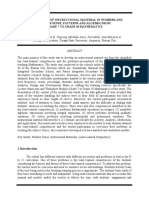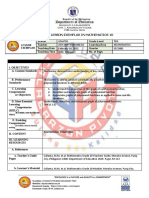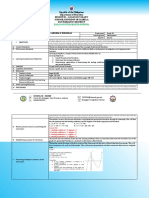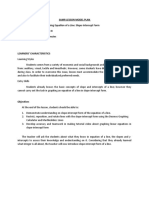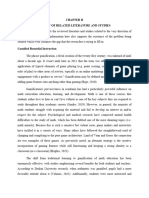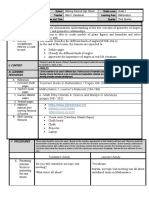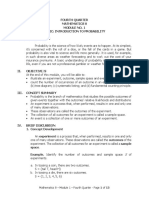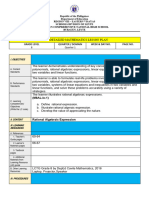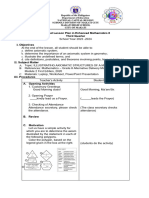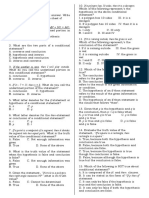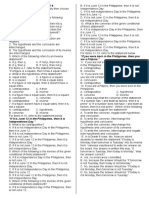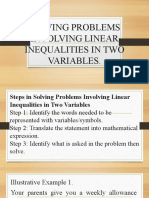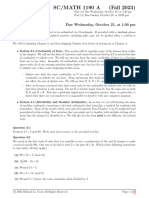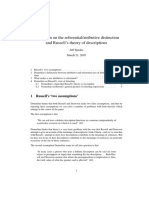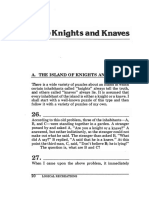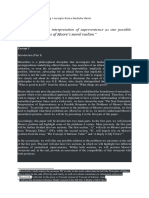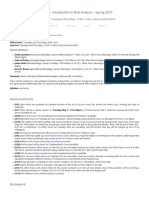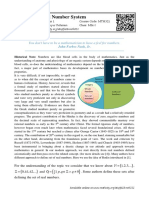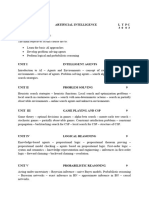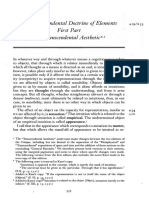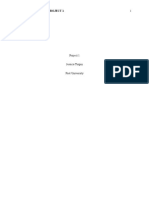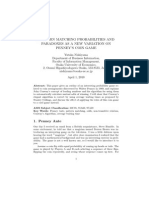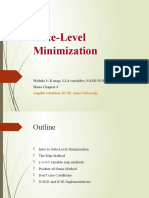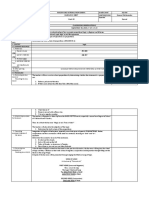Q3M2 Part 1
Uploaded by
jhonafeQ3M2 Part 1
Uploaded by
jhonafeActivity 1: Visualize me!
Directions: Complete the table below by writing the appropriate
representation of point, line, and plane found in the box. (Crosswise)
Point Line Plane
N/A N/A
N/A N/A N/A
Top of the table Edge of the cabinet Tip of a pencil
Edge of a book Tip of a marker Wall of a classroom
Stretched rope Edge of a ruler Cellphone screen
Corner of a rectangular tray
Answer Key
Point Line Plane
Tip of a Marker Edge of a Book Top of the Table
Tip of a Pencil Edge of the Wall of a Classroom
Cabinet
Corner of a Edge of a Ruler Cellphone Screen
Rectangular tray
Stretched Rope
Illustrating
Axiomatic
Structures of a
Mathematical
System
Quarter 3 – Module 2
The Axiomatic System
An axiomatic system is a logical system which
possesses an explicitly stated set of axioms from
which theorems can be derived. From the definition, you
could say that axiomatic system consists of some
undefined terms (also called the primitive terms),
defined terms, list of axioms or postulates concerning
the undefined terms, a system of logic (or proofs) to be
used in deducing new statements called theorems.
Examples of the Axiomatic System
● Robots are increasingly used in many industries in
the whole world, from healthcare and manufacturing
to defense and education. For instance, a certain
robot is being used in an industry or establishment
to do a particular activity. Suppose that the
statements below describe the routine for such
robot to control activity in a warehouse:
● Set of statements:
● Statement 1: Every robot has at least two paths.
● Statement 2: Every path has at least two robots.
● Statement 3: A minimum of one robot exist.
● In these set of statements, which do you think are
terms that need to be defined?
● Suppose you are asked to prove another statement,
say, “a minimum of one robot exists”, can you use
these three statements to prove it?
● The set of statements above are true and contain
terms that are undefined or needs to be defined.
These statements can be used to create and to
prove another statement. These set of statements
are examples of an axiomatic system.
The Structure of the System
● The axiomatic structure of a mathematical
system can be compared to a tree.
● The ground is not part of the tree but it is
necessary for the tree to be planted and to
grow. Like the ground, an axiomatic system
needs a logical system of rules that allows
one to make inferences.
● The roots at the base of the tree correspond
to the undefined and defined terms of the
system. These are the basic term from
which statements in the axiomatic system
are made. Like the tip roots combined to
build up roots of the tree, undefined terms
are the starting point for every definition and
statement of the system. They are combined
in various ways into a statement called the
definition.
● Terms are defined for us to be precise and concise on its
meaning. But there are some basic terms of the system that are
necessarily left undefined. When we define a term, we will be
using different terms that we also
need to define. For instance,
we want to define the word “set”.
Looking up for the word “set” in the
dictionary, you will find that “set is
a group of objects or numbers.
” Then you also have to define the term
“group”, which means “collection”,
and collection means “set”.
The process is a circular definition.
Thus, there are basic terms left undefined to prevent circular
definition.
● The trunk of the tree corresponds to the
axioms or postulates while the branches
growing out of that trunk are the theorems.
Axioms are the statements that serve as a
starting point for the system. Axioms are the
basic truths and we used them to prove
other statements. Theorems, on the other
hand, are statements deduced from the
axioms and clarify what is true within the
axioms.
Properties of
the Axiomatic
System
Its 3 Properties
01 – Consistency
● An axiomatic system is said to be
consistent if there are no axiom or
theorem that contradict each other.
This means that it is impossible to
derive both a statement and its
negation from the axiom set of system:
Axiom statement: There exist two lines
that are parallel.
Negation: No two lines are parallel.
Notice that the negation is not an axiom
nor a theorem.
The system where a statement and its
negation are both true is said to be
inconsistent system.
An axiomatic system should be consistent
for it to be logically valid.
This means that there are no axiom or
theorems that contradict each other.
Otherwise, the axiomatic system and its
statements are all faulty or inaccurate.
02 - Independence
● In an axiomatic system, an axiom or
postulate is said to be independent if it
is not a theorem that follows the other
axioms. It is not a theorem that can be
derived or cannot be proven true using
other axioms in the system.
● For instance, you have four different
axioms. If you can make a model
showing that one axioms is
independent of the other, that is, you
cannot use the other three axioms to
prove such axiom, then the axiom is
independent.
● An example to this is Euclid‟s fifth
Postulate. Many people tried to prove
this axiom but either failed or used
faulty reasoning. This problem led to
the development of other geometries
where the fifth theorem of Euclid was
shown to be independent of the other
postulates. (Independence is not a
necessary requirement for an
axiomatic system.)
03 – Completeness
An axiomatic system is complete if for
every statement, either itself or its
negation, is derivable in that system. In
other words, every statement is
capable of being proven true or false.
Now that you have learned the axiomatic system,
let us try to apply it in the situation mentioned
earlier about the artificial axiomatic system
describing a routine for a computer to control
activity of the robot in a warehouse. The set of
axioms given were:
Axiom 1. Every robot has at least two paths.
Axiom 2. Every path has at least two robots.
Axiom 3. A minimum of one robot exists.
What are the undefined terms in this axiom set?
Answer:
In this system, the undefined terms are “robot”, “path”
and “has”. The terms “robot” and “path” are elements
and the term “has” is a relation. This indicates that
there is some relationship between robot and path.
These undefined terms can be used to build construct
to various proofs.
If you are asked to prove say, “Theorem 1. A minimum of one
robot exists,” how would you do it?
Answer:
Notice that Axiom 3 guarantees that a robot exist but no axiom
clearly states that there is a path. The sequence of proof could
be as follow:
Proof:
1. By the third axiom, a robot exists.
2. By the first axiom, the existing robot must have at least
one path.
3. Therefore, at least one path for a robot to exists.
[Notice that Axiom 3 is a consequence of Axiom 1 and Axiom 2.]
•What is the minimum number of paths? Prove it.
Answer: Notice that Axiom 1 states that every robot
has at least two paths. Hence, the minimum
number of paths is two.
Proof:
1. By the third axiom, a robot exists, call it .
2. By the first axiom, must have at least two
paths call them and
. 3. Therefore, at least two paths exist.
The example above clearly shows that an
axiomatic system is a collection of axioms,
or statement about undefined terms, from
which proofs and theorems The or logical
arguments are built. follo wing are some
examples and illustrations of each part in
the axiomatic structure.
Math
Undefined Terms
Undefined Terms
● Axiomatic structure started with three undefined
terms (or primitive terms): point, line, and plane.
These terms are the bases in defining new terms,
hence they are called the building blocks of
geometry. Even though they are called undefined
terms, it does not really mean that we are
restricted to describe or represent them.
● Below shows the different ways of describing
these three undefined terms.
Point
● A point is a figure with no length and
width or simply with no dimension.
● A point is named using a CAPITAL
LETTER and it can be modeled by a dot.
● All other geometric figures are made up
of collection of points.
Examples of a Point
● Tip of a Pen
Line
● A line has no width and no thickness
but it can be extended infinitely in
opposite directions.
Example of a Line
● Edge of a Cabinet
Plane
● A flat surface that extends infinitely in all
directions. It is like an “infinite sheet of
paper”. It has length and width but no
thickness.
● It is named by a single script CAPITAL
LETTER or by any three points in the plane
which are not on the same line.
Examples of a Plane
● Top of a
Table
● Now look around you, can you name something in your
place that would illustrate point, line, and plane?
● A point can be The line below is line The parallelogram
represented with a dot and AB, denoted by the symbol
below is a plane denoted is denoted by a capital , which is
named after by the Greek Letter , read letter. the two
points that are on as „alpha‟. This plane can
● The two points below the line. also be named as plane are
point A and point B. Lines can also be ABC
Defined Terms
Defined Terms
● From these three undefined terms, important
concepts in geometry will be defined. Remember
that we need defined terms because we want to be
precise and concise on the meaning of a term.
Definitions will enable us to understand each other
and to make sure we mean the same thing about a
certain term.
Below are some definitions derived from the
undefined terms, point, line, and plane.
1. Definition of a Segment
Segment , denoted by or , is the union
of points A, B and all the points between
them. and are called the endpoints of the
segments
● ●
A B
2. Definition of Between
● Point is said to be between and
if and only if, , and are distinct
points of the same line and
3. Definition of Collinear Points and Coplanar
Points
● When points are on the same line, they are called
collinear points. D
●
Note that points A, B,
and C are on the same line,
hence they are said to be ● ● ●
collinear, while point D is A B C
not on the same line with
the other three, thus, these
four points A, B, C, and D are noncollinear.
● When points are on the same plane they are
called coplanar points.
Notice that points B, I,
and G are on the same
plane P, hence they are
said to be coplanar.
Can points and lines be coplanar? The answer is yes. As long as they
are on the same plane, they are said to be coplanar like the one
illustrated below.
In the figure, points J, O, Y, and
line N are all on the same plane
● hence they are said to be
coplanar.
4. Definition of a Ray
● Ray is the union of (a) and (b) all points
such that is between and
In the figure above, ray PQ starts from point P
and goes on to the right without bound. P is
called the endpoint of . Can you call it ray
PR? The answer is yes.
5. Definition of an Angle
● An angle is the union of two noncollinear
rays with a common endpoint.
- The common endpoint being
shared by UT and UV is point U
called the vertex. The angle
formed could be named as
TUV or VUT
6. Definition of Congruent Angles
Two angles are congruent if and only if their
measures are equal.
In symbol: , only if
●
7. Definitions of Acute Angle, Right Angle, and
Obtuse Angle
● An acute angle is an angle with a measure
greater than but less than .
A right angle is an angle with a measure of .
An obtuse angle is an angle with a measure
greater than but less than .
Acute Angle
Right Angle
Obtuse Angle
8. Definition of Adjacent Angles
● Adjacent angles share a common vertex
and a common side, but do not overlap.
9. Definition of Supplementary Angles
● Two angles are supplementary when
the sum of their angles is 180°.
10. Definition of Linear Pairs
● A linear pair of angles is formed when two
lines intersect. Two angles are said to be
linear if they are adjacent angles formed by
two intersecting lines and are
supplementary.
B is the common side, BA
and BC are opposite rays,
ABD and CBD a linear pair
forms
11. Definition of Vertical Angles
● Angles that are opposite each other
and formed by two intersecting lines
are vertical
1 and 3 are vertical
angles, 2 and 4 are
also vertical
angels. Noticed
that these angles
are opposite to
each other
12. Definition of Perpendicular Lines
● Perpendicular lines are two lines
intersect to form a right angle
A
AB and CD intersects at point E
C D
B
13. Definition of Perpendicular Bisector
● A perpendicular bisector of a line
segment is a line segment perpendicular
to and passing through the midpoint.
⊥
PR XZ at point Y. PR
divides XZ into 2 equal
parts. Thus mXY mZY.
Furthermore XY ≅ ZY
14. Definition of Polygon
● A polygon is the union of three or more
coplanar segments, which intersect at
endpoints, with each endpoint shared
by only two noncollinear segments.
B D
A C E
Polygon Not Polygon
Point C is shared by
more than two
segments
15. Definition of Convex Polygon
● A polygon is convex if and only if the
lines containing the sides of the
polygon do not contain points in its
interior
If each diagonal,
endpoints, is
B
C entirely in its
Exterior
Interior
exterior of the
polygon, not the
A interior of the
D
polygon then the
polygon is convex
16. Definition of Nonconvex Polygon
●A polygon is nonconvex if and
only if at least one of its sides
is contained in a line, which
contains also points in the
interior of the polygon.
17.Definition of Regular Polygon
●A regular polygon is a polygon that
is both equilateral and
equiangular.
18.Definition of a Triangle
● A triangle is a three-sided polygon
19. Definition of Angle Bisector of a Triangle
● An angle bisector of a triangle is a
segment contained in the ray,
which bisects the angle of the
triangle, and whose endpoints are
the vertex of this angle and a point
on the opposite side.
ΔOE is an angle
bisector of ΔLOV. It is
the bisector of LOV.
The endpoint of the
angle bisector is the
vertex of LOV and the
other endpoint E is on
the opposite side.
Thus, LOE ≅ EOV
20. Definition of an Altitude of a Triangle
● A segment is an altitude of a
triangle if and only if it is
perpendicular from a vertex of the
triangle to the line that contains
the opposite side.
21. Definition of Median
● A segment is a median of a triangle
if and only if its endpoints are a
vertex and the midpoint of the
opposite side
22. Definitions of Acute, Right, Obtuse, and
Equiangular Triangle
● An acute triangle is a triangle in which
all angles are acute.
● A right triangle is a triangle in which
one of the angles is a right angle.
● An obtuse triangle is a triangle in
which one of the angles is obtuse.
● An equiangular triangle is a triangle in
which all angles are congruent.
O D S
D
Y A
T R Y U N
H
Acute Right Obtuse Equiangular
Triangle Triangle Triangle Triangle
23. Definitions of Scalene, Isosceles, and
Equilateral Triangle
● A scalene triangle is a triangle with
no congruent sides.
● An isosceles triangle is a triangle
with at least two congruent sides.
● An equilateral triangle is a triangle
with all sides congruent.
●
Scalene Triangle
●
H R
Isosceles Triangle
B
BG ≅
BI
G I
Equilateral Triangle
BA ≅ AC ≅ BC
MATH
Axioms
● In the axiomatic structure of a mathematical
system, axiom is defined as a logical
statement accepted to be true without proof.
Axioms can be used as a premise in a
deductive argument. In the Elements, Euclid
presented 10 assumptions, five of which are
not specific to geometry, and he called them
common notions (axioms), while the other five
are specifically geometric in which he called
them postulates.
Common Notions
(Axioms)
Axiom 1
●
-Things which are equal to the same
thing are also equal to one another.
This is transitive property of equality
Axiom 2
● If equals are added to equals, the
wholes are equal. This is addition
property of equality.
Axiom 3
● If equals are subtracted from
equals, the remainders are equal.
This is subtraction property of
equality
Axiom 4
●Things which coincide with one
another are equal to one another.
This is reflexive property
Axiom 5
● The whole is greater than the part
The following axioms below are both
used in geometry and other field of
mathematics.
Symmetric Property of Equality
Substitution Property of Equality
● For all real numbers 𝑝 and 𝑞, if 𝑝 = 𝑞, then 𝑞
can be substituted for 𝑝 in any expression
Geometrical
Postulates Q3
Postulate 1
● A straight line segment can be drawn
joining any two distinct points.
Postulate 2
● Any straight line segment can be
extended indefinitely in a straight line.
Postulate 3
● Given any straight line segment, a circle can
be drawn having the segment as radius and
one endpoint as center.
Postulate 4
● All right angles are congruent.
Postulate 5
● If a straight line meets two other lines, so as
to make the two interior angles on one side
of it together less than two right angles, the
other straight lines will meet if produced on
that side which the angles are less than two
right angles.
● Postulate 5 asserts that two distinct
straight lines in a plane are either
parallel or meet exactly in one point.
● Postulate 5 is referred to as the
parallel line postulate. This postulate
was questions by many
mathematicians. To them, the
postulate seemed less obvious that the
others and claimed that it should be
proven rather than simply accepting it
as a fact.
● The following are other postulates
about point, line, plane, and figures
formed by these and the basic
postulates.
Segment Addition Postulate
● If points 𝑃, 𝑄 and 𝑅 are collinear and
point 𝑄 is between points 𝑃 and 𝑅,
then 𝑃𝑄 + 𝑄𝑅 = 𝑃𝑅
Angle Measurement Postulate
● To every angle there corresponds a
unique real number 𝑟 where 0 < 𝑟 <
180°
In geometry, angles are
measures
in units called degrees.
In symbol °. Angle FUN
is 45 degrees. In
notation, 𝑚∠𝐹𝑈𝑁 = 45°
Angle Addition Postulate
The sets of axioms (or
postulates) you just learned
were used to deduce new
propositions or to prove other
statements using the rules of
inference of a system
of logic. In other words, the
system of logic is your proof.
Euclid used deductive A System of Logic
reasoning in organizing the (Proof)
Euclidian geometry.
Theorems
● Theorems are the new statements
which are deduced or proved using
sets of axioms, system of logic, and
previous theorems. These are
statements accepted after proven
deductively
The following are some theorems about
points, lines, and planes.
Activity 1: Make me meaningful
● Directions: The following is an axiomatic system. Answer each
question as required.
● Axiom Set:
● Axiom 1: Each line is a set of three points.
● Axiom 2: Each point is contained by two lines.
● Axiom 3: Two distinct lines intersect at exactly one point.
● Questions:
● 1. What are the undefined terms in this axiom set?
● 2. Is the axiomatic system consistent? Why? Why Not? State
what specific property is the given axiomatic system
Answer Key #1
● 1. Line and Point
2. No, because an axiomatic system is consistent, if
there is no statement such that both the statement
and it's negation are axioms or theorems of the
axiomatic system. An axiomatic system that does
not have the property of consistency has no
mathematical value and is generally not of interest.
Activity 2 “Who am I”
● Directions:
Write the
definition,
postulate, or
theorem that
supports each
statement
Answer Key #2
● 1. Segment Addition Postulate
2. Angle Addition Postulate
3. Definition of Supplementary Angles
Activity 3: Write the missing reasons
● Directions: Using the figure below write the missing reasons
corresponding to its statement. Number six is done for you.
Answer Key #3
● 1. Given
2. Angle Addition Postulate
3. Angle Addition Postulate
4. Substitution Property
5. Reflexive Property
Activity 4: Identify and Illustrate
● Directions: Given the properties, identify whether it is a
theorem or postulate and illustrate.
Answer Key #4
What I have learned
After going through with this module, it’s now time to check what you
have learned from the activities. Read carefully and answer the items
that follow.
Directions: Tell whether the following statement is true or false.
● 1. T
2. F
3. T
4. F
5. T
6. F
7. T
8. T
9. F
10. T
Let’s get this real
● At this point, you will be given a practical task which
will demonstrate your understanding on axiomatic
system.
● Directions: Read the situation below and answer the
questions that follow
Situation: Teacher Clarenda wanted to group here students into
committees. She is grouping them according to the following
axiom set:
Axiom 1: Each committee consists of exactly two members.
Axiom 2: There are exactly six committees.
Axiom 3: Each member serves on exactly two committees.
Questions:
What are the undefined terms in the axiom set?
Let a dot represent a member, and a line represent a committee,
make at least one concrete model of the axiom set.
Deduce the theorem that “there is a finite number of member.”
● 1. Committee and Member
2.
3. By axiom 1 a member exist. By axiom 2 there are
exactly 6 committees. Therefore there is a finity
number of members
You might also like
- Applications of Systems of Linear Equations in Two Variables ExercisesNo ratings yetApplications of Systems of Linear Equations in Two Variables Exercises8 pages
- Illustrating Axiomatic Structures of Mathematical System: Math 8 RecapNo ratings yetIllustrating Axiomatic Structures of Mathematical System: Math 8 Recap47 pages
- Module 1 - Searching For Patterns, Sequence and SeriesNo ratings yetModule 1 - Searching For Patterns, Sequence and Series24 pages
- Strategic Intervention Material: (Equation of A Line)100% (1)Strategic Intervention Material: (Equation of A Line)17 pages
- Gorgonio, Mark Levi B., Pag-Ong, Michelle Joyce, Porcadilla, Jean Marjorie ANo ratings yetGorgonio, Mark Levi B., Pag-Ong, Michelle Joyce, Porcadilla, Jean Marjorie A16 pages
- Pivot 4A Lesson Exemplar in Mathematics 10No ratings yetPivot 4A Lesson Exemplar in Mathematics 107 pages
- Unit 01 Lesson 02 Point Line and Plane PostulatesNo ratings yetUnit 01 Lesson 02 Point Line and Plane Postulates8 pages
- Permutation Group: Jocelyn F. Goyena Bicol University100% (1)Permutation Group: Jocelyn F. Goyena Bicol University46 pages
- Department of Education: 4 QUARTER - Module 3No ratings yetDepartment of Education: 4 QUARTER - Module 312 pages
- Daily Lesson Plan of M8Al-Ih-1: Annex 18 Deped Order No. 42, S, 2016No ratings yetDaily Lesson Plan of M8Al-Ih-1: Annex 18 Deped Order No. 42, S, 20163 pages
- March 25, 2021 Lesson Plan in Mathematics Grade 8 Content StandardsNo ratings yetMarch 25, 2021 Lesson Plan in Mathematics Grade 8 Content Standards8 pages
- I. Objectives: Ellanie D. Nason Grade 10 July 05, 2022No ratings yetI. Objectives: Ellanie D. Nason Grade 10 July 05, 20226 pages
- Q4 L5 G7 Solving Simple Equations Using Bar ModelNo ratings yetQ4 L5 G7 Solving Simple Equations Using Bar Model5 pages
- 62f896029b19ea001261ce5f-1660465185-Math 8 - Q2W1No ratings yet62f896029b19ea001261ce5f-1660465185-Math 8 - Q2W115 pages
- Objectives:: Semi-Detailed Lesson Plan in Elementary AlgebraNo ratings yetObjectives:: Semi-Detailed Lesson Plan in Elementary Algebra4 pages
- 4Q - M8 - Module 1 - Introduction To Probability (Approved)No ratings yet4Q - M8 - Module 1 - Introduction To Probability (Approved)13 pages
- Mathematics7 - Q4 - Mod28 - Measures of Variability Ungrouped Data - V5No ratings yetMathematics7 - Q4 - Mod28 - Measures of Variability Ungrouped Data - V527 pages
- Section 3.8-3.10 Domain and Range Practice WorksheetNo ratings yetSection 3.8-3.10 Domain and Range Practice Worksheet3 pages
- Department of Education: Republic of The PhilippinesNo ratings yetDepartment of Education: Republic of The Philippines13 pages
- Assessment AND Evaluation IN: Mathematics AS 16 MATH 115 Week 2No ratings yetAssessment AND Evaluation IN: Mathematics AS 16 MATH 115 Week 27 pages
- Mathematics 8: Quarter 4 - Module 3 Basic Concepts of ProbabilityNo ratings yetMathematics 8: Quarter 4 - Module 3 Basic Concepts of Probability4 pages
- Differentiating Finite Geometric Sequence From An Infinite Geometric100% (1)Differentiating Finite Geometric Sequence From An Infinite Geometric5 pages
- GE Math - Learning Module 8 - AY 2021 2022No ratings yetGE Math - Learning Module 8 - AY 2021 20226 pages
- Carlos Hilado Memorial State College: Student InvestigatorsNo ratings yetCarlos Hilado Memorial State College: Student Investigators15 pages
- Detailed Lesson Plan in Mathematics I .Content StandardsNo ratings yetDetailed Lesson Plan in Mathematics I .Content Standards9 pages
- Module 4.1: Linear Equations in One Variable: ObjectivesNo ratings yetModule 4.1: Linear Equations in One Variable: Objectives4 pages
- WEEK 8.1. Lesson Plan Solution Linear EquationNo ratings yetWEEK 8.1. Lesson Plan Solution Linear Equation7 pages
- Solving Problems Involving Linear Inequalities in Two VariablesNo ratings yetSolving Problems Involving Linear Inequalities in Two Variables28 pages
- Illustrating Axiomatic Structures of A Mathematical System 2No ratings yetIllustrating Axiomatic Structures of A Mathematical System 229 pages
- Donnellan On The Referential/attributive Distinction and Russell's Theory of DescriptionsNo ratings yetDonnellan On The Referential/attributive Distinction and Russell's Theory of Descriptions6 pages
- Smullyan What Is The Name of This Book Chapter 3No ratings yetSmullyan What Is The Name of This Book Chapter 37 pages
- Aleksa Markovic, Pardubice, Moore ExcerptsNo ratings yetAleksa Markovic, Pardubice, Moore Excerpts9 pages
- What Is Difference Between Thesis Statement and Topic Sentence100% (2)What Is Difference Between Thesis Statement and Topic Sentence5 pages
- Explain Knowledge Representation(Prolog) in AINo ratings yetExplain Knowledge Representation(Prolog) in AI14 pages
- DERRIDA's DECONSTRUCTION As A Method of Analysis of LanguageNo ratings yetDERRIDA's DECONSTRUCTION As A Method of Analysis of Language58 pages
- Instructor's Resource Guide To Accompany Discrete Mathematics and Its Applications, 8e Kenneth H. Rosen all chapter instant downloadNo ratings yetInstructor's Resource Guide To Accompany Discrete Mathematics and Its Applications, 8e Kenneth H. Rosen all chapter instant download50 pages
- Theorems Corollaries Lemmas and Methods of Proof 1st Edition Richard J. Rossi pdf download100% (1)Theorems Corollaries Lemmas and Methods of Proof 1st Edition Richard J. Rossi pdf download60 pages
- Kakatiya Institute of Technology & Science, WarangalNo ratings yetKakatiya Institute of Technology & Science, Warangal4 pages
- Gate-Level Minimization: Module 3: K Map 2,3,4 Variables NAND/NOR Mano Chapter 3No ratings yetGate-Level Minimization: Module 3: K Map 2,3,4 Variables NAND/NOR Mano Chapter 345 pages
- (Abner Shimony) The Search For A Naturalistic WorlNo ratings yet(Abner Shimony) The Search For A Naturalistic Worl350 pages
- Abductive Thinking and Sensemaking - The Drivers of Design SynthesisNo ratings yetAbductive Thinking and Sensemaking - The Drivers of Design Synthesis11 pages
- Ten Lectures On Cognitive Linguistics George Lakoff pdf download100% (2)Ten Lectures On Cognitive Linguistics George Lakoff pdf download86 pages
- Daily Lesson Plan: School Grade Level Teacher Learning Areas Teaching Week QuarterNo ratings yetDaily Lesson Plan: School Grade Level Teacher Learning Areas Teaching Week Quarter5 pages
- Chapter 12 - Revision of Chapters 9-11: Solutions To Technology-Free QuestionsNo ratings yetChapter 12 - Revision of Chapters 9-11: Solutions To Technology-Free Questions35 pages








